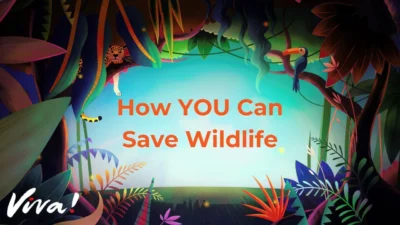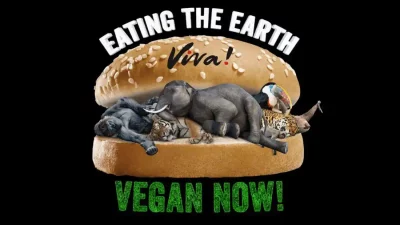Wildlife Map Case Studies
Discover the animals at risk of extinction due to our deadly meat, dairy, fish and egg appetites.

Brown howler monkey
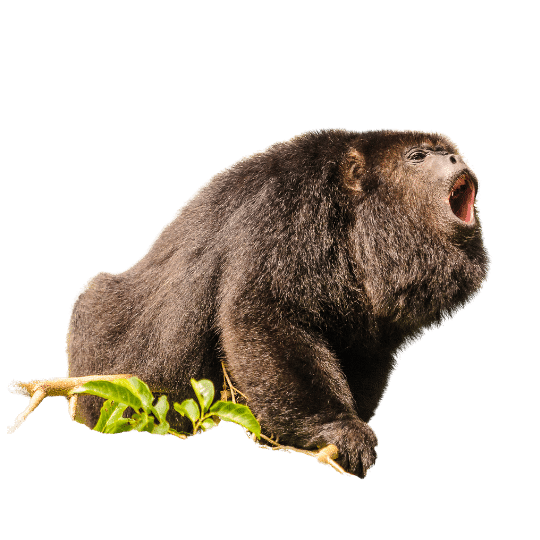
Populations of brown howler monkeys have been severely declining over the last few decades, having suffered extensive habitat loss due to the land conversion of their Atlantic Forest habitat for cattle grazing and soya production in Brazil and Argentina. The northern brown howler monkey is classified as critically endangered. The remaining forest is extremely fragmented into hundreds of isolated patches, most too small to support viable populations in the long term. As they are pushed closer to human populations, due to increased demand for meat and dairy, attacks by domesticated dogs, traffic incidents and electrocution from are becoming serious threats to howlers living close to urban areas4Schwitzer C, Mittermeier RA, Rylands AB et al. (eds). 2019. Primates in peril: The world’s 25 most endangered primates 2018-2020. IUCN SSC Primate Specialist Group, International Primatological Society, Global Wildlife Conservation and Bristol Zoological Society. Washington, DC. .
Brown howler monkeys are highly susceptible to yellow fever, with increased exposure thought to be driven by a combination of climate change and habitat fragmentation 5Conservation Breeding Specialist Group. 2013. Brown Howler Monkey Conservation Workshop. Available at: http://www.cbsg.org/sites/cbsg.org/files/documents/FINAL%20REPORT%20-%20I%20Brown%20Howler%20Monkeys%20Conservation%20Workshop.pdf . Over the next few decades, increased pathogen exposure along with habitat loss puts these primates at serious risk of extinction. Without them, we would lose a vital seed disperser for numerous plant species 6Schwitzer C, Mittermeier RA, Rylands AB et al. (eds). 2019. Primates in peril: The world’s 25 most endangered primates 2018-2020. IUCN SSC Primate Specialist Group, International Primatological Society, Global Wildlife Conservation and Bristol Zoological Society. Washington, DC. – and maybe even the rainforest itself.
Ecuadorian white-fronted capuchin

If you can spot them, you will find the Ecuadorian white-fronted capuchin nibbling on mature fruit in the tropical and subtropical forests of Peru and Ecuador. With their distribution over the last few decades having reduced to less than one per cent of their original range, they are classified as critically endangered with their numbers dwindling in the wild. Habitat loss and fragmentation is the overriding threat, with 70 per cent of the original forest cover having been converted for other uses – primarily for agriculture and cattle ranching 10Schwitzer C, Mittermeier RA, Rylands AB et al. (eds.). 2019. Primates in peril: The world’s 25 most endangered primates 2018-2020. IUCN SSC Primate Specialist Group, International Primatological Society, Global Wildlife Conservation and Bristol Zoological Society. Washington, DC. ; products which are later consumed in the UK. Like most tropical primates, they are integral to the health of both the rainforest’s and the planet, acting as seed dispersers, helping with forest regeneration and growth. This in turn provides habitat for other species and enables carbon absorption11Bourlière F. 1985. Primate communities: Their structure and role in tropical ecosystems. International Journal of Primatology. 6 (1) 1-26. .
Ecuadorian white-fronted capuchins thrive in forested areas with more than 25 per cent tree cover and low human population12Campos FA, Jack KM. 2013. A potential distribution model and conservation plan for the Critically Endangered Ecuadorian capuchin, Cebus albifrons aequatorialis. International Journal of Primatology. 34 (5) 899 – 916. . Therefore, forest conservation is essential for any hopes of survival – this can’t be done if their vital habitat and space is constantly being seized to feed our demand for meat and dairy.
Toucan
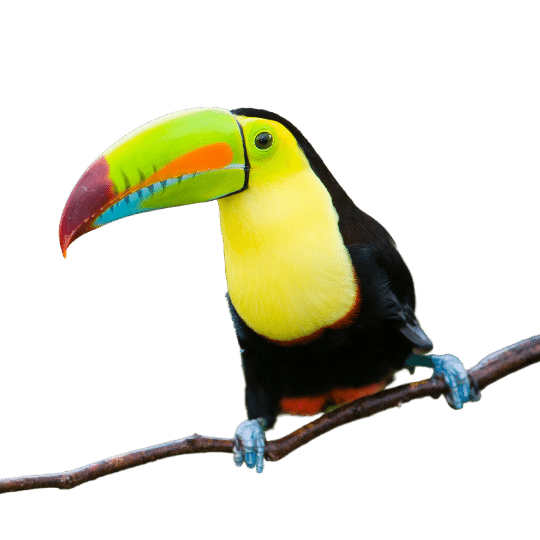
An iconic bird of the Amazon, these unique birds are famous for their colourful and strikingly large bills. A highly social species, they have been found to gather in flocks of up to 20 individuals. But they are under threat.
These exotic birds live in the tropics of America, favouring old-growth forests to nest in. Over a fifth of their species face eradication with 11 out of 50 species being threatened or near threatened with extinction16BirdLife International. 2022. Toucans. Available at: https://www.birdlife.org/birds/toucans/ [Accessed on 19 June 2022]. , fuelled by the UK’s appetite for meat and dairy. Deforestation in the Amazon basin to make way for cattle and soya production destroys the jungle habitats they are dependent on for survival 17BirdLife International. 2016. Ramphastos tucanus. The IUCN Red List of Threatened Species 2016: e.T22682153A92932045. Available at: https://dx.doi.org/10.2305/IUCN.UK.2016-3.RLTS.T22682153A92932045.en [Accessed on 19 June 2022]. . Toucans are essential in preserving the lungs of our planet – they are excellent seed dispersers helping spread fruit trees far and wide that reabsorb carbon emissions18BirdLife International. 2022. Toucans. Available at: https://www.birdlife.org/birds/toucans/ [Accessed on 19 June 2022]. .
Jaguar

Once free to roam across the Amazon basin, these wild cats now cover just half of their historic range, as their habitats become increasingly fragmented due to conversion of tropical forest for soya crops and cattle ranching26Quigley H, Foster R, Petracca L et al. 2017. Panthera onca (errata version published in 2018). The IUCN Red List of Threatened Species 2017: e.T15953A123791436. Available at: https://dx.doi.org/10.2305/IUCN.UK.2017-3.RLTS.T15953A50658693.en [Accessed on 19 June 2022]. The United Nations state that the biggest threat to global forests is agriculture, with soya for cattle feed being a key culprit27UN News. 2019. Ensuring the ‘lungs of the planet’ keep us alive: 5 things you need to know about forests and the UN. Available at: https://news.un.org/en/story/2019/05/1038291 [Accessed on 19 June 2022] . In fact, over three–quarters of soya grown globally is fed to farmed animals 28Ritchie H, Roser M.2021. “Forests and Deforestation”. Our World In Data. Available at: https://ourworldindata.org/forests-and-deforestation [Accessed on 19 June 2022]. .
Produce of this prolific habitat destruction is mainly used for exports; the UK imports most of its soya from South America 29 EFECA. 2018. UK Roundtable on Sustainable Soya: Baseline study 2018. Available at: http://www.efeca.com/wp-content/uploads/2018/11/UK-RT-on-Sustainable-Soya-baseline-report-Oct-2018.pdf – where only 20–30 per cent of it can be certified as sustainable30Walter F. 2020. Soy in the UK: What are its uses?. Table Debates. Available at: https://tabledebates.org/blog/soy-uk-what-are-its-uses#:~:text=What%20is%20clear%20from%20estimations,in%20poultry%20and%20pig%20production [Accessed on June 19 2022] .
The severe fragmentation of the jaguar’s home lowers the densities of jaguars and their prey in the dwindling forest patches, this pushes jaguars closer to human-populations to hunt out alternative food sources, leading to an increase in human-wildlife conflict. Habitat loss has already resulted in jaguars becoming extinct in El Salvador and Uruguay. Protected forest zones aren’t enough to save the jaguar – the loss of corridors between surviving populations is threatening population collapse since most require connectivity between core sites to survive in the long term. The majority of these corridors are outside of these protected areas31Quigley H, Foster R, Petracca L et al. 2017. Panthera onca (errata version published in 2018). The IUCN Red List of Threatened Species 2017: e.T15953A123791436. Available at: https://dx.doi.org/10.2305/IUCN.UK.2017-3.RLTS.T15953A50658693.en [Accessed on 19 June 2022].
These majestic animals play a vital role for ecosystem health. Jaguars are the top predators in their environment, so they are essential for controlling the populations of other species. This helps keep a balance in the food chain and secures a healthy environment32WWF. 2022. Jaguar: The Amazon’s Amazing Swimming Cat. Available at: https://www.wwf.org.uk/learn/wildlife/jaguars [Accessed on 19 June 2022].
Sloth
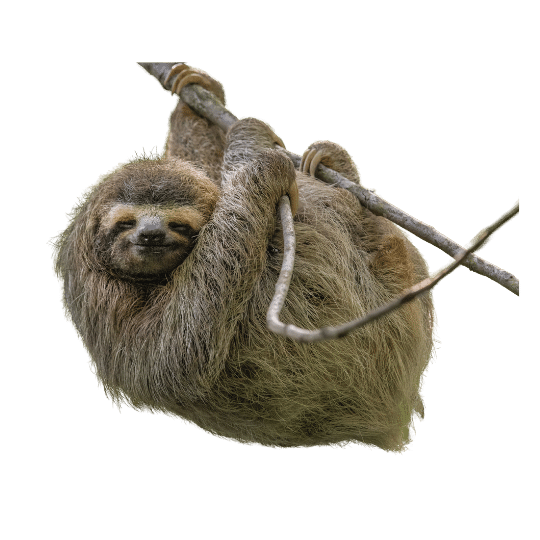
There are six species of sloth that are at home in the tropical canopy of Central and South America41WWF. 2022. Sloth. Available at: https://www.worldwildlife.org/species/sloth [Accessed on 19 June 2022]. – at least two of which have recorded large population decreases42IUCN. 2022. Sloth. Available at: https://www.iucnredlist.org/search?query=sloth&searchType=species [Accessed on 19 June 2022].. The health of sloths is dependent on the health and expanse of the rainforest – they need an abundance of trees for shelter, food and protection43WWF. 2022. Sloth. Available at: https://www.worldwildlife.org/species/sloth [Accessed on 19 June 2022].. Sloths only urinate and defecate once a week, and when they do, they become exposed and vulnerable to predators44Kaup M, Trull S, Hom EF. 2021. On the move: sloths and their epibionts as model mobile ecosystems. Biological Reviews. 96 (6) 2638-2660. . Deforestation is a constant threat; the more trees that get chopped down to make way for beef cattle grazing, the more time that sloths spend on the ground 45Bellanatonio M, Yousefi A. 2016. The ultimate mystery meat: Exposing the secrets behind Burger King and global meat production.. In essence without their trees, they will not survive.
Demand for beef cattle and animal feed is the number one driver for deforestation of tropical forests46 Vaughan A. 2019. Deforestation in Brazil has rocketed since Bolsonaro became president. New Scientist. Available at: https://www.newscientist.com/article/2210621-deforestation-in-brazil-has-rocketed-since-bolsonaro-became-president/ [Accessed on 19 June 2022]. . And these products might be closer than you think – shocking investigations have found that products from mega corporations behind this deforestation, such as the Brazilian meat production giant JBS, are being sold in UK supermarkets and supplied to the NHS47Mendonca E, Wasley A, Holder M. 2021. Revealed: UK supermarkets linked to beef suppliers driving illegal Amazon Deforestation. Business Green. Available at: https://www.businessgreen.com/news-analysis/4035275/revealed-uk-supermarkets-linked-beef-suppliers-driving-illegal-amazon-deforestation [Accessed on 19 June 2022]..
Sloths are a key element of the rainforest ecosystem. In fact, their fur is also a whole ecosystem in itself, with tiny animals living in their hair eating the algae that grows there48Kaup M, Trull S, Hom EF. 2021. On the move: sloths and their epibionts as model mobile ecosystems. Biological Reviews. 96 (6) 2638-2660. . Meat and dairy not only threaten the sloth, but all the moths, beetles, cockroaches and worms that call the sloth a home.
African cheetah
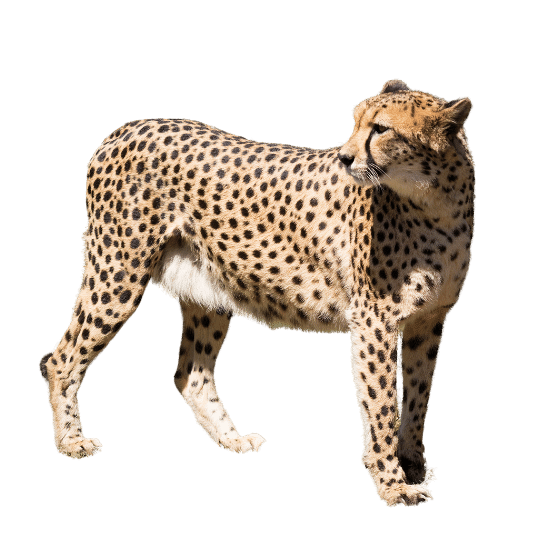
Listed as vulnerable on the IUCN red list, the African cheetah is a wide-ranging carnivore that’s particularly vulnerable to habitat loss and fragmentation, as they require a much larger area of land to survive than most other carnivore species. As their wild lands are destroyed and the corridors between existing wild areas are lost due to human activities, such as animal agriculture, cheetah population numbers are facing a steep decline55Durant S, Mitchell N, Ipavec A et al. 2015. Acinonyx jubatus. The IUCN Red List of Threatened Species 2015: e.T219A50649567. Available at: https://dx.doi.org/10.2305/IUCN.UK.2015-4.RLTS.T219A50649567.en [Accessed on 19 June 2022]. . Once found across Africa, they now only cover 10 per cent56African Wildlife Foundation. 2022. Cheetah. Available at: https://www.awf.org/wildlife-conservation/cheetah#:~:text=Cheetahs%20tend%20to%20encounter%20conflict,farmers%20killing%20them%20in%20retaliation [Accessed 19 June 2022]. of their historic range having gone extinct in over 30 countries57Durant S, Mitchell N, Ipavec A et al. 2015. Acinonyx jubatus. The IUCN Red List of Threatened Species 2015: e.T219A50649567. Available at: https://dx.doi.org/10.2305/IUCN.UK.2015-4.RLTS.T219A50649567.en [Accessed on 19 June 2022]. , and most of the known cheetah range existing on unprotected lands58African Wildlife Foundation. 2022. Cheetah. Available at: https://www.awf.org/wildlife-conservation/cheetah#:~:text=Cheetahs%20tend%20to%20encounter%20conflict,farmers%20killing%20them%20in%20retaliation [Accessed 19 June 2022]. .
Less than 7,000 adults remain in the wild. As numbers of their wild prey dwindles there is also an increased risk of them being killed in human-wildlife conflict, if they end up having to rely on livestock as a food source59Durant S, Mitchell N, Ipavec A et al. 2015. Acinonyx jubatus. The IUCN Red List of Threatened Species 2015: e.T219A50649567. Available at: https://dx.doi.org/10.2305/IUCN.UK.2015-4.RLTS.T219A50649567.en [Accessed on 19 June 2022]. . As a top predator they are essential for ecosystem regulation; without a healthy cheetah population our food systems are under threat – populations of herbivores would increase, which can deplete soil fertility60Allen S. (2020) The impact of the loss of top predators on terrestrial ecosystems. Routes. 1 (1) 61–68. .
African forest elephant
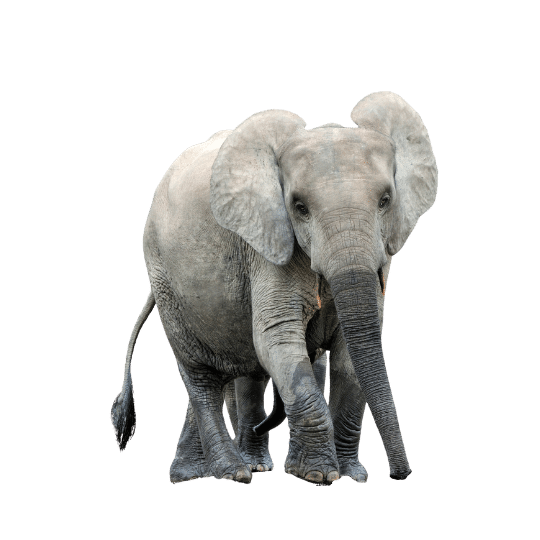
Found stomping across the forests of west and central Africa64Gobush KS, Edwards CTT, Maisels F et al. 2021. Loxodonta cyclotis (errata version published in 2021). The IUCN Red List of Threatened Species 2021: e.T181007989A204404464. Available at: https://dx.doi.org/10.2305/IUCN.UK.2021-1.RLTS.T181007989A204404464.en [Accessed on 20 June 2022]. , this largest living terrestrial mammal plays an essential role in combating the human-induced climate crisis as they trample smaller plants to create space for trees to grow larger and store more carbon. Coupled with their role as seed dispersers, these elephants are crucial for a healthy biodiversity and humanity’s future survival. It is predicted that if elephants were to go extinct, the amount of carbon stored in central African rainforests could fall by 7 per cent! This loss would reduce the biomass of African forests by about three gigatonnes of carbon – equivalent to 14 years’ worth of carbon emissions from the UK 65Berzaghi F, Longo M, Ciais P et al. 2019. Carbon stocks in central African forests enhanced by elephant disturbance. Nature Geoscience. 12, 725-729.. This scary image could soon become reality as rapid land use change for agriculture and livestock drives habitat loss and fragmentation with them currently being listed as critically endangered on the IUCN Red List66Gobush KS, Edwards CTT, Maisels F et al. 2021. Loxodonta cyclotis (errata version published in 2021). The IUCN Red List of Threatened Species 2021: e.T181007989A204404464. Available at: https://dx.doi.org/10.2305/IUCN.UK.2021-1.RLTS.T181007989A204404464.en [Accessed on 20 June 2022]..
Mountain gorilla

Living in the high-altitude forests of Uganda, Rwanda and the Democratic Republic of the Congo, the endangered Eastern mountain gorillas are running out of space to live, as the impacts of the climate crisis, coupled with land use pressure from human populations, force them to migrate upslope. Rising temperatures and changes in rainfall patterns threaten the gorilla’s food availability and the quality of the remaining isolated forest patches that have not been converted for agricultural use70Plumptre A, Robbins MM, Williamson EA. 2019. Gorilla beringei. The IUCN Red List of Threatened Species 2019: e.T39994A115576640. Available at: https://dx.doi.org/10.2305/IUCN.UK.2019-1.RLTS.T39994A115576640.en [Accessed on 19 June 2022]. .
Mountain gorillas are also victims of poaching and the illegal bushmeat trade. Worryingly the hunting, preparing and consuming of bushmeats contributes to the spread of viral diseases such as Ebola or bacterial infections which spill over from wildlife to human populations71Plumptre A, Robbins MM, Williamson EA. 2019. Gorilla beringei. The IUCN Red List of Threatened Species 2019: e.T39994A115576640. Available at: https://dx.doi.org/10.2305/IUCN.UK.2019-1.RLTS.T39994A115576640.en [Accessed on 19 June 2022]. . With less than 1,200 remaining in the wild, and limited space northwards left – these Gorillas need our help72UNEP. 2021. COVID-19, climate change threaten last refuge of the mountain gorilla. https://www.unep.org/news-and-stories/story/covid-19-climate-change-threaten-last-refuge-mountain-gorilla.
Freshwater pearl mussels
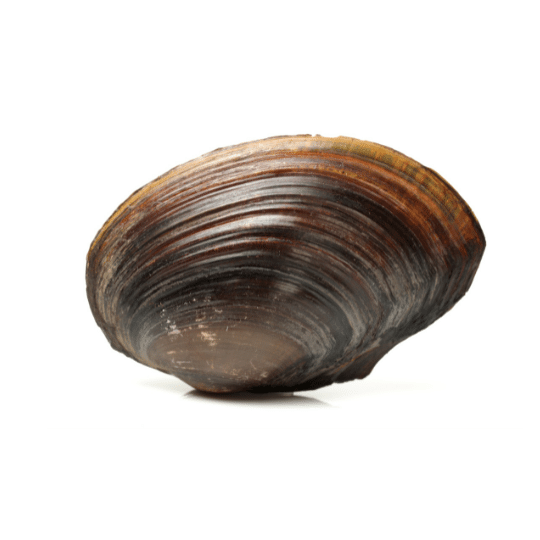
The freshwater pearl mussel requires cool, well-oxygenated water free of pollution for population stability79JNCC. 2022. Freshwater pearl mussel (Margaritifera margaritifera) – Special Areas of Conservation. Available at: https://sac.jncc.gov.uk/species/S1029/ [Accessed 19 June 2022].. However, with increased pollution and nutrient overload sucking the oxygen from the river, these mussels have seen a steep decline in their numbers80Hayhow DB, Eaton MA, Stanbury AJ et al. 2019. The State of Nature 2019. The State of Nature partnership., being listed as endangered by the IUCN81Moorkens E, Cordeiro J., Seddon MB et al. 2017. Margaritifera margaritifera (errata version published in 2018). The IUCN Red List of Threatened Species 2017: e.T12799A128686456. Available at: https://dx.doi.org/10.2305/IUCN.UK.2017-3.RLTS.T12799A508865.en [Accessed on 19 June 2022].. While formerly widespread throughout western and northern parts of Britain, there now only exists one viable population of freshwater pearl mussels in England in Cumbia, and the viable populations in Scotland are also under threat of decline82JNCC. 2022. Freshwater pearl mussel (Margaritifera margaritifera) – Special Areas of Conservation. Available at: https://sac.jncc.gov.uk/species/S1029/ [Accessed 19 June 2022]. .
One key source of this nutrient pollution is from animal agriculture, for instance slurry, septic tank leakage and agricultural run-off. Overgrazing itself poses a serious threat with the loss of vegetation releasing fine sediment into their river habitat, cutting off their oxygen supply. Climate change is also an encroaching threat, with the species likely to be affected by future changes in rainfall patterns and temperatures83Moorkens E, Cordeiro J., Seddon MB et al. 2017. Margaritifera margaritifera (errata version published in 2018). The IUCN Red List of Threatened Species 2017: e.T12799A128686456. Available at: https://dx.doi.org/10.2305/IUCN.UK.2017-3.RLTS.T12799A508865.en [Accessed on 19 June 2022].. This population decline has greater species implications, since mussels improve water quality through filtration for other species, such as fish, eels and otters84JNCC. 2022. Freshwater pearl mussel (Margaritifera margaritifera) – Special Areas of Conservation. Available at: https://sac.jncc.gov.uk/species/S1029/ [Accessed 19 June 2022]. .
Brown bear

Once stretching across the entire continent of Europe, from Turkey to the UK, and up into the Arctic circle 91McLellan BN, Proctor MF, Huber D et al. 2017. Ursus arctos (amended version of 2017 assessment). The IUCN Red List of Threatened Species 2017: e.T41688A121229971. Available at: https://dx.doi.org/10.2305/IUCN.UK.2017-3.RLTS.T41688A121229971.en [Accessed on 19 June 2022]., Brown bears, also known as grizzly bears, are now only found in two per cent of their former range92WWF.2022. Brown Bear. Available at: https://www.worldwildlife.org/species/brown-bear#:~:text=Formerly%20hunted%20for%20its%20hides%2C%20meat%2C%20and%20as,due%20to%20their%20size%2C%20valuable%20furs%20and%20meat [Accessed on 19 June 2022].. While previously their biggest threats were hunting and use as game trophies, increasingly habitat loss, fragmentation and degradation due to human activities, such as livestock farming, are resulting in population declines93McLellan BN, Proctor MF, Huber D et al. 2017. Ursus arctos (amended version of 2017 assessment). The IUCN Red List of Threatened Species 2017: e.T41688A121229971. Available at: https://dx.doi.org/10.2305/IUCN.UK.2017-3.RLTS.T41688A121229971.en [Accessed on 19 June 2022].94Temple HJ, Terry A. 2007. The status and distribution of European mammals. The status and distribution of European mammals.. In Europe, four of ten subpopulations are critically endangered due to this habitat loss, with isolated populations of brown bears being pushed into human-populated areas, increasing human–wildlife conflict95McLellan BN, Proctor MF, Huber D et al. 2017. Ursus arctos (amended version of 2017 assessment). The IUCN Red List of Threatened Species 2017: e.T41688A121229971. Available at: https://dx.doi.org/10.2305/IUCN.UK.2017-3.RLTS.T41688A121229971.en [Accessed on 19 June 2022].). Since these bears depend on large natural areas, they are important indicators for a range of other wildlife species and help keep overall animal population numbers in balance. These large mammals also are crucial for ecosystems spreading seeds over large areas of land 96WWF.2022. Brown Bear. Available at: https://www.worldwildlife.org/species/brown-bear#:~:text=Formerly%20hunted%20for%20its%20hides%2C%20meat%2C%20and%20as,due%20to%20their%20size%2C%20valuable%20furs%20and%20meat [Accessed on 19 June 2022]..
Atlantic puffin

Living most of their lives at sea and only coming to land to breed, the Atlantic puffin, also dubbed the sea parrot101National Geographic. 2022. Atlantic Puffin. Available at: https://www.nationalgeographic.com/animals/birds/facts/atlantic-puffin [Accessed on 19 June 2022] , is an unfortunate victim of our demand for meat, dairy, fish and eggs. The Atlantic puffin is extremely vulnerable to the adverse effects of the climate crisis, which the meat and dairy industry contribute to heavily, due to prey shifts and increased sea temperatures. With their breeding populations confined to a small number of sites, any changes to the environment could have catastrophic consequences on the puffin’s population. Increased extreme weather events also pose a threat to these sea dwelling birds102BirdLife International. 2018. Fratercula arctica. The IUCN Red List of Threatened Species 2018: e.T22694927A132581443. Available at: https://dx.doi.org/10.2305/IUCN.UK.2018-2.RLTS.T22694927A132581443.en [Accessed on 19 June 2022]. .
Pressures on food availability is exacerbated by the fishing industry exploiting the seas fish reserves, resulting in low breeding success103BirdLife International. 2018. Fratercula arctica. The IUCN Red List of Threatened Species 2018: e.T22694927A132581443. Available at: https://dx.doi.org/10.2305/IUCN.UK.2018-2.RLTS.T22694927A132581443.en [Accessed on 19 June 2022]. . Due to declining population and projected future trends, they are now classified as vulnerable and are included on the Red List of UK Birds of Conservation Concern104RSPB. 2022. Threats. Available at: https://www.rspb.org.uk/birds-and-wildlife/wildlife-guides/bird-a-z/puffin/threats/ [Accessed on 19 June 2022]. .
Sudeten ringlet (Erebia sudetica)
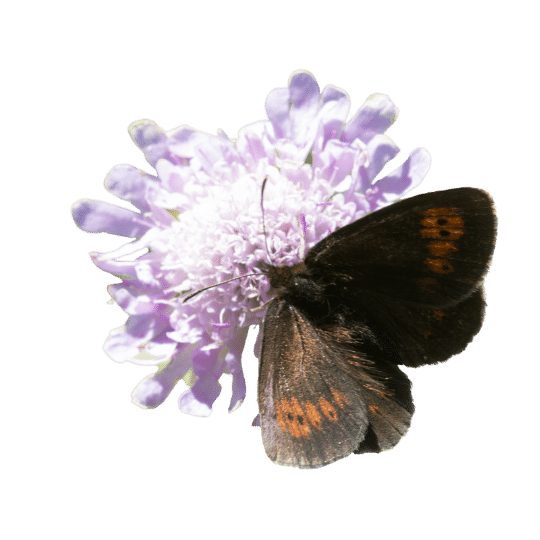
Native to Europe’s alpine and subalpine grasslands the Sudeten ringlet can be found fluttering between rocky mountain peaks and inland cliffs108 Swaay CV, Wynhoff I, Verovnik R et al. 2010. Erebia sudetica. The IUCN Red List of Threatened Species 2010: e.T39492A10233214. Available at: https://dx.doi.org/10.2305/IUCN.UK.2010-1.RLTS.T39492A10233214.en [Accessed on 19 June 2022].. Due to intensified grazing practices from farmed animal’s, populations of the Sudeten ringlet have declined by more than 30 per cent in last 10 years and it is now classified as vulnerable109Swaay CV, Cuttelod A, Collins S et al. 2010. European red list of butterflies. Luxembourg: Publication Office of the European Union. Available at: https://portals.iucn.org/library/sites/library/files/documents/RL-4-011.pdf. .
Butterflies are critical for a healthy ecosystem and have been supporting the flourishing of biodiversity for at least 50 million years. Alongside making up an important element of the food chain, they also provide environmental benefits such as pollination and natural pest control110Butterfly Conservation. NA. Why butterflies matter. Available at: https://butterfly-conservation.org/butterflies/why-butterflies-matter [Accessed on 19 June 2022]. – key for humanity’s continued survival.
Bumblebee

As one of the most important pollinators for food crops, bees are integral to our food security. According to the European Red List of Bees, around a quarter of bumblebee species in Europe are threatened with extinction, with shifting agricultural practice and intensification of farming resulting in habitat loss and degradation, driving this population decline. Increased grazing from livestock has resulted in large scale losses of herb-rich grasslands, with a 97 per cent decline in enclosed semi-natural grasslands in England and Wales.
This large-scale habitat loss is devastating for bee populations, especially bumblebees who are especially susceptible. Herbicides and pesticides use are also a major threat to bees115A, Roberts SPM, Kemp J et al. 2014. European Red List of bees. Luxembourg: Publication Office of the European Union. Available at: https://ec.europa.eu/environment/nature/conservation/species/redlist/downloads/European_bees.pdf. – many of which116Dimbleby, H. 2021. The National Food Strategy: The Plan – July 2021. Available at: https://www.nationalfoodstrategy.org/the-report/. are used on the 55 per cent land area of crops grown to feed the farmed animals in the UK117Farmers for Stock Free Farming. 2022. Revisioning Britain. Available at: https://farmersforstockfreefarming.org/revisioning-britain/ [Accessed on 19 June 2022]. . Moreover, the climate crisis is also increasingly becoming a threat to bee populations across Europe due to shifting habitats and weather conditions118A, Roberts SPM, Kemp J et al. 2014. European Red List of bees. Luxembourg: Publication Office of the European Union. Available at: https://ec.europa.eu/environment/nature/conservation/species/redlist/downloads/European_bees.pdf. .
The red wolf

The red wolf of Eastern North Carolina is critically endangered, it’s predicted that there only 20 – 30 individuals left in the wild124Phillips M. 2018. Canis rufus (errata version published in 2020). The IUCN Red List of Threatened Species 2018: e.T3747A163509841. Available at: https://dx.doi.org/10.2305/IUCN.UK.2018-2.RLTS.T3747A163509841.en [Accessed on 19 June 2022]. , down from 400 in the 1980s. The main driver of this extensive population decline – habitat loss and fragmentation to make room for agriculture coupled with the wolves being victims of predator-control programmes as they are considered a threat to livestock125Endangered Wonders. NA. Red Wolf. Available at: https://endangeredwonders.org/red-wolf/ [Accessed on 19 June 2022].. An agricultural leader in the US, North Carolina is a key contributor to the meat and dairy industry; it is the second in the nation for pig farming126NASS. 2021. 2021 State Agriculture Overview. Available at: https://www.nass.usda.gov/Quick_Stats/Ag_Overview/stateOverview.php?state=NORTH%20CAROLINA [Accessed on 19 June 2022]., and soya is the biggest crop produced127The University of North Carolina. 2022. Agriculture in North Carolina: Crops and Livestock. Available at: https://guides.lib.unc.edu/nc_agriculture/crops [Accessed on 19 June 2022].. And with over three quarters soya crops world-wide – used for animal feed128Ritchie H, Roser M.2021. “Forests and Deforestation”. Our World In Data. Available at: https://ourworldindata.org/forests-and-deforestation [Accessed on 19 June 2022]., the link between the demise of the red wolf and meat and dairy demand is clear.
American bison

The largest mammal in North America, the migratory wild American bison currently occupy less than 1.2 per cent of their original range132Aune K, Jørgensen D, Gates C. 2017. Bison bison (errata version published in 2018). The IUCN Red List of Threatened Species 2017: e.T2815A123789863. Available at: https://dx.doi.org/10.2305/IUCN.UK.2017-3.RLTS.T2815A45156541.en [Accessed on 19 June 2022].. Driven to near extinction in the past their population now stands at around 12,000, compared to a population in excess of 40 million back in the late 18th century133Endangered Wonders. NA. American Bison. Available at: https://endangeredwonders.org/american-bison/#:~:text=Only%20a%20small%20fraction%20of%20American%20Bison%20lives,in%20genetic%20diversity%20and%20crossbreeding%20with%20domestic%20cattle [Accessed on 19 June 2022].. Nowadays the grazing of livestock, primarily cattle and sheep, has the largest negative impacts on bison populations. This is due to; damage to soil and vegetation that make up the bison’s food source, disease transmission from livestock to free-roaming bison, and livestock infrastructure blocking the natural movement of the migratory herds134 Buffalo Field Campaign. 2020. Livestock Diseases. Available at: https://www.buffalofieldcampaign.org/livestock-diseases [Accessed on 19 June 2022]. .
Gulf of Mexico, marine dead zone
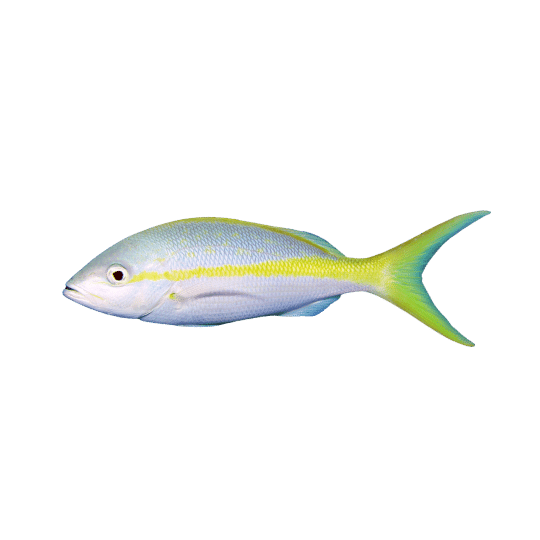
Once rich with marine diversity, the Gulf of Mexico is now classified as a dead zone, so depleted of oxygen it kills fish and other marine life140NOAA. 2021. Happening Now: Dead Zone in the Gulf 2021. Available at: https://oceantoday.noaa.gov/deadzonegulf-2021/ [Accessed on 19 June 2022].. Past inhabitants include the yellowtail snapper (pictured), the gray triggerfish and the greater amberjack141NOAA. 2020. Federally Managed Gulf of Mexico Reef Fish. Available at: https://www.fisheries.noaa.gov/species/federally-managed-gulf-mexico-reef-fish [Accessed on 19 June 2022]. In 2021, this dead zone was measured at 6,334 square miles – equivalent to nearly more than four million acres of habitat142NOAA. 2021. Happening Now: Dead Zone in the Gulf 2021. Available at: https://oceantoday.noaa.gov/deadzonegulf-2021/ [Accessed on 19 June 2022].! The Gulf of Mexico dead zone is not an isolated problem – factory farms are responsible for more than 500 nitrogen-flooded dead zones across the world’s oceans, due to animal waste and agricultural run-off143Cowspiracy. 2014. The Facts. Available at: https://www.cowspiracy.com/facts [Accessed on 19 June 2022].. This run-off essentially suffocates fish and marine life, with the overload of nutrients causing deadly algae blooms which removes all oxygen from the water144NOAA. 2021. What is a dead zone? Available at: https://oceanservice.noaa.gov/facts/deadzone.html [Accessed on 19 June 2022]. – making it unable to support life.
Orangutan
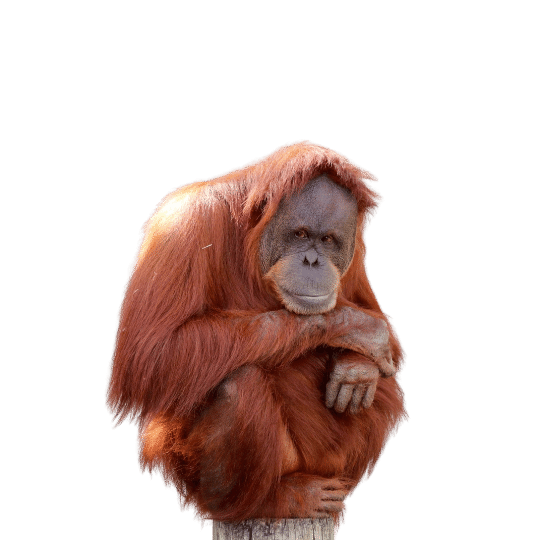
Home to the tropical forests of Sumatra and Borneo, Asia’s only great ape is facing extinction due to our food choices150WWF Australia. 2018. Orangutan. Available at: https://www.wwf.org.au/what-we-do/species/orangutan [Accessed on 19 June 2022]. . Rapidly expanding oil palm plantations are seizing the homes of these orangutan, with 90 per cent of the world’s oil palms currently grown in Malaysia and Indonesia151WWF Australia. 2018. Palm oil. Available at: https://www.wwf.org.au/what-we-do/food/palm-oil. [Accessed on 19 June 2022]. . As key seed dispersers, orangutans are essential in maintaining forest ecosystems, supporting neighbouring wildlife152WWF Australia. 2018. Orangutan. Available at: https://www.wwf.org.au/what-we-do/species/orangutan [Accessed on 19 June 2022]. .
This vital habitat is deforested, decimating orangutan populations and exacerbating the climate crisis, so that palm oil can be used in half of all supermarkets shelf products153UNEP. 2016. Conservationists and palm oil industry should collaborate to protect great apes, fragile ecosystems. Available at: www.un.org/apps/news/story.asp?NewsID=55520#.WXiya4jyu70 [Accessed on 19 June 2022]. . However, it isn’t just found in beauty products and cheap food; one of the key products made from palm kernels is animal feed, primarily for cattle and sheep, with the UK importing around a tenth of the world’s palm kernel for these purposes154Proforest. 2011. Mapping and understanding the UK palm oil supply chain. London: Publication Office of the Department for Environment, Food and Rural Affairs. Available at: https://www.plant-talk.org/documents/UKpalmoil.pdf. .
Hairy-nosed otter

Having inhabited the earth for the last 30 million years, the world’s rarest otter can159International Otter Survival Fund. 2022. Otter Species. Available at: https://www.otter.org/Public/AboutOtters_OtterSpecies.aspx?speciesID=12 [Accessed on 19 June 2022]. now only be found in a handful of South-eastern Asian countries including Cambodia, Vietnam and Thailand and is classified as endangered on the IUCN Red List. They are highly dependent on their habitats of lowland wetland forests for survival, many of which are cleared to grow plantations such as palm oil and soya crops160Sasaki H, Aadrean A, Kanchanasaka B et al. 2021. Lutra sumatrana. The IUCN Red List of Threatened Species 2021: e.T12421A164579488. Available at: https://dx.doi.org/10.2305/IUCN.UK.2021-3.RLTS.T12421A164579488.en [Accessed on 19 June 2022].. With over three quarters of the world’s soya crops used for animal feed161Ritchie H, Roser M.2021. “Forests and Deforestation”. Our World In Data. Available at: https://ourworldindata.org/forests-and-deforestation [Accessed on 19 June 2022]., there is a clear link between meat and dairy and decline in these otter populations. The fishing industry is also a key player in the otter’s demise – with fish traps causing otters to drown162Sasaki H, Aadrean A, Kanchanasaka B et al. 2021. Lutra sumatrana. The IUCN Red List of Threatened Species 2021: e.T12421A164579488. Available at: https://dx.doi.org/10.2305/IUCN.UK.2021-3.RLTS.T12421A164579488.en [Accessed on 19 June 2022]..
Panda
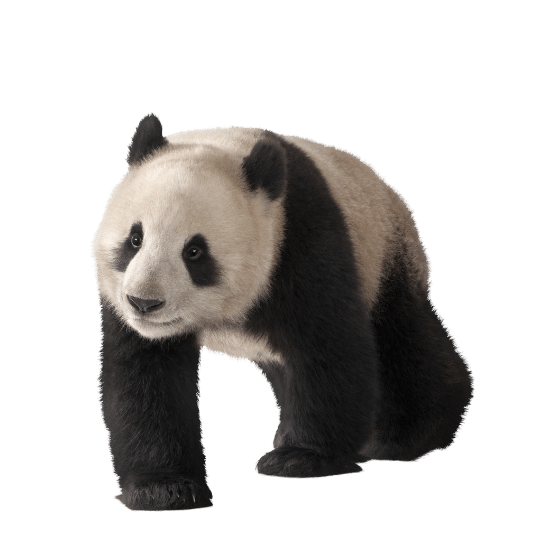
An iconic image of global conservation, it is well known that the giant panda needs help. They once roamed across eastern and southern China, Vietnam and northern Myanmar, but are now isolated to only six separated mountain ranges166WWF. Na. Giant Pandas: Living Proof that Conservation Works. Available at: https://www.wwf.org.uk/learn/wildlife/giant-pandas#challenges-affecting-pandas [Accessed on 19 June 2022]. . Human activity is the key driver of their decline, with livestock farming now the most observed disturbance of the panda’s habitat, pushing them out of their homes and isolating populations, making them vulnerable to additional threats. The climate crisis is predicted to worsen these impacts, including the widescale loss of bamboo, their primary food source. As they are forced closer to human populations, close contact with livestock and domesticated animals increases novel pathogen transferal, further threatening panda populations167Swaisgood R, Wang D, Wei F. 2016. Ailuropoda melanoleuca (errata version published in 2017). The IUCN Red List of Threatened Species 2016: e.T712A121745669. Available at: https://dx.doi.org/10.2305/IUCN.UK.2016-2.RLTS.T712A45033386.en [Accessed on 19 June 2022]. .
Not only are they of cultural and economic significance to China, but they are also crucial to keeping their mountain forest habitats healthy as key seed dispersers. This helps protect many other important and threatened species who share the same biodiverse rich habitat as the panda, such as snow leopards and takins168WWF. Na. Giant Pandas: Living Proof that Conservation Works. Available at: https://www.wwf.org.uk/learn/wildlife/giant-pandas#challenges-affecting-pandas [Accessed on 19 June 2022]. .
Red panda
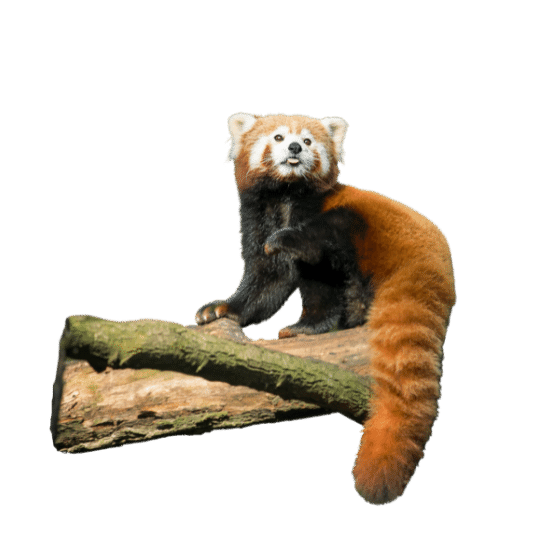
Hidden in the branches of the montane forests of Bhutan, China, India, Myanmar and Nepal, the red panda is gravely under threat due to demand for meat and dairy. They are the only member of its animal family, the Ailuridae – making it unique in the animal kingdom172National Geographic. 2022. Red panda. Available at: https://www.nationalgeographic.com/animals/mammals/facts/red-panda [Accessed on 19 June 2022]. . The major threats to the red panda’s survival include habitat loss, and fragmentation and degradation, due to the expansion of human communities and livestock farming173Glatston A, Wei F, Than Zaw et al. 2015. Ailurus fulgens (errata version published in 2017). The IUCN Red List of Threatened Species 2015: e.T714A110023718. Available at: https://dx.doi.org/10.2305/IUCN.UK.2015-4.RLTS.T714A45195924.en [Accessed on 19 June 2022]. .
Cattle herds invade the forests trampling and eating bamboo – the red panda’s primary food source. Coupled with the increasing negative impacts of the climate crisis of habitat shifting and extreme weather events, the red panda is vulnerable to extinction if no action is taken – with them currently being listed as endangered on the IUCN index174Glatston A, Wei F, Than Zaw et al. 2015. Ailurus fulgens (errata version published in 2017). The IUCN Red List of Threatened Species 2015: e.T714A110023718. Available at: https://dx.doi.org/10.2305/IUCN.UK.2015-4.RLTS.T714A45195924.en [Accessed on 19 June 2022]. .
Greater one-horned rhino
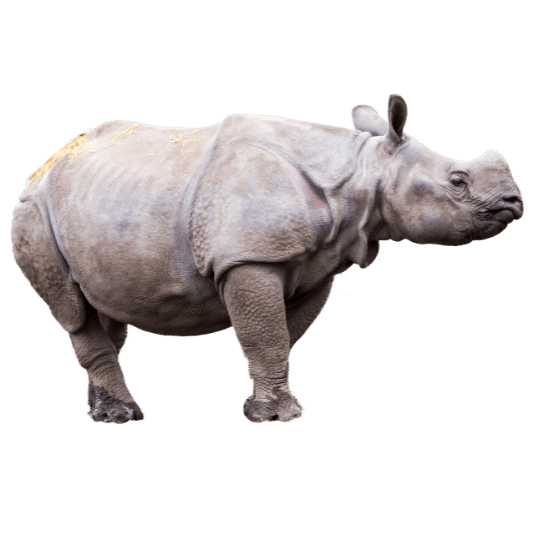
Rhinos have been around for nearly 40 million years178Rhino Fund Uganda. 2022. Why Save Rhinos?. Available at: https://www.rhinofund.org/about-rhinos/why-save-rhinos#:~:text=%20Why%20Save%20Rhinos%3F%20%201%20Rhinos%20are,population%2C%20rangers%20and%20scientists%20take%20in…%20More%20 [Accessed on 19 June 2022]. but now with only 2,100 – 2,200 individuals left in the wild, the greater one-horned rhino is vulnerable to extinction – and they are under threat from more than just poaching. Grazing by domestic livestock greatly reduces the quality of the rhino’s habitat. In Chitwan National Park, home to the second largest population, decline in calving rate and other reproductive indicators has been linked to change in habitat quality, with there being heavy livestock grazing pressure and disturbance in buffer zone areas. They are also vulnerable to the impacts of the climate crisis, such as increased storms and flooding179Ellis S, Talukdar B. 2019. Rhinoceros unicornis. The IUCN Red List of Threatened Species 2019: e.T19496A18494149. Available at: https://dx.doi.org/10.2305/IUCN.UK.2019-3.RLTS.T19496A18494149.en [Accessed on 19 June 2022]. . With meat and dairy responsible for a around a fifth of global greenhouse gas emissions180Xu X, Sharma P, Shu S et al. 2021. Global greenhouse gas emissions from animal-based foods are twice those of plant-based foods. Nature Food. 2, 724-732. , the food choices we make in the UK can directly impact this rhino’s chance of survival.
Hooded seal

At home deep diving in the waters of the Arctic and sub-Arctic, Hooded Seals are increasingly under threat due to the human-induced climate crisis. Listed as vulnerable on the IUCN index185Kovacs, K.M. 2016. Cystophora cristata. The IUCN Red List of Threatened Species 2016: e.T6204A45225150. Available at: https://dx.doi.org/10.2305/IUCN.UK.2016-1.RLTS.T6204A45225150.en [Accessed on 19 June 2022]. , the hooded seal has seen a 90 per cent decline over the past few decades due to regional sea ice reduction, as a result of rising global temperatures186Fuller S, Brooks R et al. 2016. Biodiversity: The ravages of guns, nets and bulldozers. Nature. 536, 143–145. . As a pack ice species, they are highly dependent on the ice for their short breeding season. The reduction in sea ice is also impacting the productivity of the ice-edge ecosystems, gravely reducing the availability of the hooded seal food sources187Kovacs, K.M. 2016. Cystophora cristata. The IUCN Red List of Threatened Species 2016: e.T6204A45225150. Available at: https://dx.doi.org/10.2305/IUCN.UK.2016-1.RLTS.T6204A45225150.en [Accessed on 19 June 2022]. . Without this ice, their populations are under serious threat, and with meat and dairy responsible for around a fifth of global greenhouse gas emissions188Xu X, Sharma P, Shu S et al. 2021. Global greenhouse gas emissions from animal-based foods are twice those of plant-based foods. Nature Food. 2, 724-732. , our diets have a lot to answer for.
Polar bear
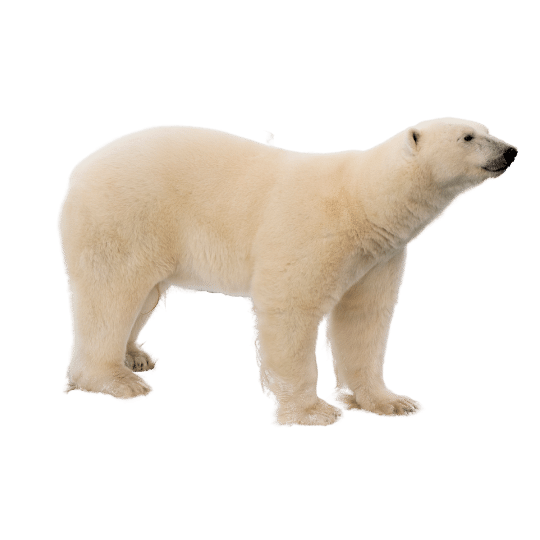
The planet’s biggest land-based carnivore is under threat… listed as vulnerable on the IUCN index, there is estimated to be around only 22,000 of individuals left in the wild193WWF. Na. Polar Bear: Icon on Ice. Available at: https://www.wwf.org.uk/learn/wildlife/polar-bears#polar-bears [Accessed on 19 June 2022]. , with populations expected to decline dramatically over the coming years as the impacts of human-induced climate crisis worsen. Dependent on arctic sea ice for their food source, rising temperatures are melting this vital landscape that polar bears depend on for survival194Wiig Ø, Amstrup S, Atwood T et al. 2015. Ursus maritimus. The IUCN Red List of Threatened Species 2015: e.T22823A14871490. Available at: https://dx.doi.org/10.2305/IUCN.UK.2015-4.RLTS.T22823A14871490.en [Accessed on 19 June 2022]. .
As top predators in the Arctic, they play a key role in balancing the local ecosystem195WWF. Na. Polar Bear: Icon on Ice. Available at: https://www.wwf.org.uk/learn/wildlife/polar-bears#polar-bears [Accessed on 19 June 2022]. . Animal agriculture emits more greenhouse gas emissions than the whole of the transport industry combined196Steinfeld H, Gerber P, Wassenaar TD et al. 2006. Livestock’s long shadow: environmental issues and options. Food & Agriculture Org. – meaning that the fate of future polar bear populations is directly tied to the food we choose to eat.
Emperor Penguin
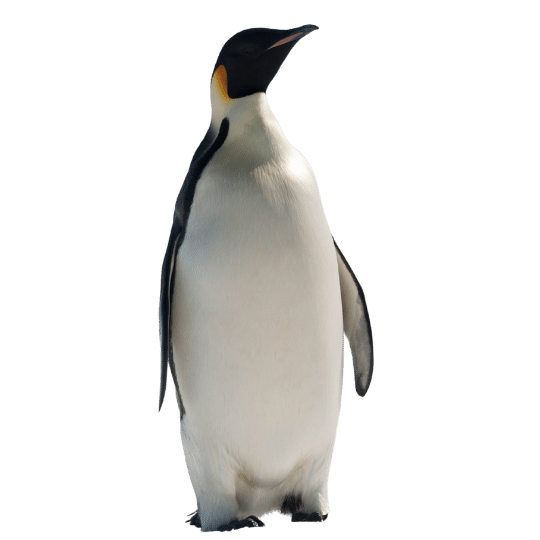
In the chilly realms of Antarctica there are around 20 million breeding pairs of penguins – many of these species however are in decline due to receding sea ice. The regal emperor penguin is one of those threatened species – with populations having declined by up to 50 per cent in some places201British Antarctic Survey. Na. Impacts of Climate Change. Available at: https://discoveringantarctica.org.uk/challenges/sustainability/impacts-of-climate-change [Accessed on 19 June 2022].. Never setting foot on land, they live and breed on the sea ice surrounding continental Antarctica202WWF. Na. Emperor Penguins – The Icons of the Antarctic. Available at: https://www.wwf.org.uk/learn/wildlife/emperor-penguins [Accessed on 19 June 2022]. , however decreases in thickness and duration of this ice is making it increasingly difficult for them to find suitable breeding locations203BirdLife International. 2020. Aptenodytes forsteri. The IUCN Red List of Threatened Species 2020: e.T22697752A157658053.Available at: https://dx.doi.org/10.2305/IUCN.UK.2020-3.RLTS.T22697752A157658053.en [Accessed on 19 June 2022]..
This issue might feel far away – but the heart of problem is closer to home than you may think! Meat and dairy are responsible for around a fifth of global greenhouse gas emissions204 Xu X, Sharma P, Shu S et al. 2021. Global greenhouse gas emissions from animal-based foods are twice those of plant-based foods. Nature Food. 2, 724-732. , a driving force behind the climate crisis which is causing these vital habitats, and their resident wildlife, to disappear.
Long-tailed bat

Bats are New Zealand’s only native land mammal, and the long-tailed bat, one of only two native bat species, are listed as threatened at a nationally critical level210Department of Conservation (NZ). Na. Bats/ pekapeka. Available at: https://www.doc.govt.nz/nature/native-animals/bats-pekapeka/ [Accessed on 19 June 2022]. and critically endangered on the ICUN Red List211O’Donnell C. 2021. Chalinolobus tuberculatus. The IUCN Red List of Threatened Species 2021: e.T4425A21985132. Available at: https://dx.doi.org/10.2305/IUCN.UK.2021-1.RLTS.T4425A21985132.en [Accessed on 19 June 2022]. . Clearance of their forested habitat to make space for agricultural intensification, such as cattle and sheep grazing, is one of the drivers for their decline212Department of Conservation (NZ). Na. Long-tailed bat. Available at: https://www.doc.govt.nz/nature/native-animals/bats-pekapeka/long-tailed-bat/ [Accessed on 19 June 2022]. . Indigenous forest, where bats roost, once covered 90 per cent of New Zealand but is now reduced to an estimated 14 per cent of its original area213Sedgeley JA, O’Donnell CF. 1999. Roost selection by the long-tailed bat, Chalinolobus tuberculatus, in temperate New Zealand rainforest and its implications for the conservation of bats in managed forests. Biological Conservation, 88 (2) 261-276. . The UK is implicit in the long-tailed bats demise, as we heavily rely on this region for lamb imports; in 2021 New Zealand was the main import country for both fresh and frozen lamb214AHDB. 2022. Sheep meat trade. Available at: https://ahdb.org.uk/lamb/sheep-meat-trade [Accessed on 19 June 2022]. .
Back to the Wildlife Map




